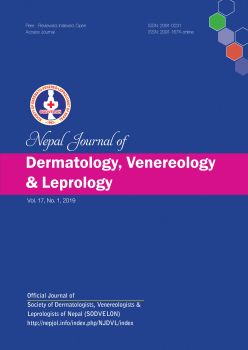Leprosy in Post Elimination Period: An Experience in a Single Tertiary Care Centre in Kathmandu, Nepal
DOI:
https://doi.org/10.3126/njdvl.v17i1.23388Keywords:
Leprosy, Nepal, Public healthAbstract
Introduction: Leprosy elimination was declared by Government of Nepal almost a decade back.
Objective: To evaluate the clinical and epidemiological profiles of leprosy patients in post elimination period
Material and Methods: Analysis of medical records of all clinically diagnosed and newly registered cases of leprosy attending Dermatology outpatient department of Tribhuvan University Teaching Hospital, Kathmandu, Nepal from 1st April 2017 to 31st March 2018 was done.
Results: Hospital based prevalence of Leprosy was found to be 0.24%, with males outnumbering females (63.6% vs 36.4%).The most common age group affected was 45-59 years with hypo-aesthetic patches/plaques and erythematous anaesthetic /hypoaesthetic patches (36.4% each) being the most common presentation. Overall, borderline leprosy was the most common diagnosis (borderline tuberculoid ,29.5% , borderline borderline, 6.8%, borderline lepromatous,11.36%). Slit skin smear positivity was found in 50% of cases.
Conclusion: Leprosy still remains a challenge for clinicians in Nepal though elimination has been achieved. A constant evaluation, monitoring and case detection should be still pursued with health education in order to make timely diagnosis and prevent deformities.
Downloads
Downloads
Published
How to Cite
Issue
Section
License
Copyright on any research article is transferred in full to Nepal Journal of Dermatology, Venereology & Leprology upon publication. The copyright transfer includes the right to reproduce and distribute the article in any form of reproduction (printing, electronic media or any other form).




